By John Treadwell Dunbar ——Bio and Archives--March 28, 2010
Travel | CFP Comments | Reader Friendly | Subscribe | Email Us
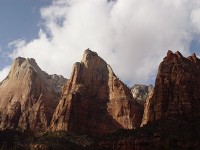 The great 19th century French novelist Gustave Flaubert, who wrote that “the three most beautiful things ever created in this world are the sea, Hamlet, and Mozart’s Don Giovanni,” had obviously never been to southern Utah because if there is a paradise on earth, this place is a top contender with its many parks, monuments and fertile desert wild lands. And of all those red-rock gems, Zion is the most visited.
The great 19th century French novelist Gustave Flaubert, who wrote that “the three most beautiful things ever created in this world are the sea, Hamlet, and Mozart’s Don Giovanni,” had obviously never been to southern Utah because if there is a paradise on earth, this place is a top contender with its many parks, monuments and fertile desert wild lands. And of all those red-rock gems, Zion is the most visited.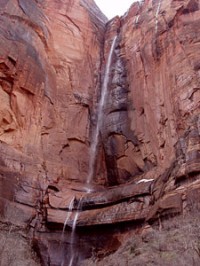 Listen carefully for the twittering wren, the croaking toad and the stealthy soft steps of the mule deer, and the gentle rustle of cottonwood leaves in the early summer breeze; and pay especially close attention to the screech and honk of the shuttle bus barreling around the Big Bend that'll send you scurrying for your life to the shoulder of the road where you watch from the weeds as another load of Lithuanians, Japanese and the French, not to mention a handful of Kentuckians, are hauled back to the quaint and delightful resort town of Springdale at the mouth of this grand canyon for lunch.
Don’t get me wrong; I LOVE Zion, everyone does, and if you don’t there’s something very wrong with you, occasional crowds notwithstanding. To borrow an opportune phrase: “Zion will blow your mind.” And I don’t really mean to disparage those clean and relatively quiet shuttle buses that ply the seven-mile upper canyon during spring, summer and fall. Truth be told, those buses saved Zion from a smelly fate that saw bumper-to-bumper traffic years ago when the park and I first met.
Listen carefully for the twittering wren, the croaking toad and the stealthy soft steps of the mule deer, and the gentle rustle of cottonwood leaves in the early summer breeze; and pay especially close attention to the screech and honk of the shuttle bus barreling around the Big Bend that'll send you scurrying for your life to the shoulder of the road where you watch from the weeds as another load of Lithuanians, Japanese and the French, not to mention a handful of Kentuckians, are hauled back to the quaint and delightful resort town of Springdale at the mouth of this grand canyon for lunch.
Don’t get me wrong; I LOVE Zion, everyone does, and if you don’t there’s something very wrong with you, occasional crowds notwithstanding. To borrow an opportune phrase: “Zion will blow your mind.” And I don’t really mean to disparage those clean and relatively quiet shuttle buses that ply the seven-mile upper canyon during spring, summer and fall. Truth be told, those buses saved Zion from a smelly fate that saw bumper-to-bumper traffic years ago when the park and I first met.
 When you think of Zion, think big, think monstrous, because the sheer size of the black-streaked, mostly-red vertical walls and buttresses is the defining characteristic that invokes Old and New Testament allegory. It’s quite fitting that these larger-than-life natural monuments project undeniable spiritual qualities, and a mandated sense of humility, found nowhere else on earth. The West Temple, Tower of the Virgins, the Watchman, the Great White Throne, Angel’s Landing - these are man’s feeble attempt to project through nomenclature a sense of the divine that even dyed-in-the-wool atheists can appreciate. Zion really is “perfect beauty,” and a photographer’s dream-come-true.
When you think of Zion, think big, think monstrous, because the sheer size of the black-streaked, mostly-red vertical walls and buttresses is the defining characteristic that invokes Old and New Testament allegory. It’s quite fitting that these larger-than-life natural monuments project undeniable spiritual qualities, and a mandated sense of humility, found nowhere else on earth. The West Temple, Tower of the Virgins, the Watchman, the Great White Throne, Angel’s Landing - these are man’s feeble attempt to project through nomenclature a sense of the divine that even dyed-in-the-wool atheists can appreciate. Zion really is “perfect beauty,” and a photographer’s dream-come-true.
 First designated as Mukuntuweap National Monument in 1909, and upgraded to Zion National Park in 1929, Zion, which evidently means a physical or spiritual“refuge” or "sanctuary" in Hebrew, anchors the southwest corner of the Colorado Plateau, a 180,000-square-mile block of stone that has been thrust upward to a height of 11,000 feet. The stone of the Colorado Plateau is soft, relatively speaking, formed by intense heat and the downward compression of deposited layers of ash, lime, sand and mud. These sediments-turned-to-stone form identifiable layers, like a stacked and staggered wedding cake, some thin, others immensely thick.
Stratigraphy is the study of these geologic layers with names like Navajo sandstone, the Kayenta and Chinle formations, Shinarump conglomerate and the like, according to this colorful brochure I’m flipping through. It says here, and I’m paraphrasing, that the inescapable force of water carved this mighty canyon and scooped it out of mother earth one patient millimeter at a time, grain by stubborn grain. Before Zion was, and before the Virgin became an identifiable river, water found its way into tiny fissures that were gradually scoured to form cracks that widened and deepened. Over time the sediments were swept away, a melting of the earth’s crust that left us with sheer slabs of sandpaper-textured walls that soar from 3,666 to 8,726 feet.
First designated as Mukuntuweap National Monument in 1909, and upgraded to Zion National Park in 1929, Zion, which evidently means a physical or spiritual“refuge” or "sanctuary" in Hebrew, anchors the southwest corner of the Colorado Plateau, a 180,000-square-mile block of stone that has been thrust upward to a height of 11,000 feet. The stone of the Colorado Plateau is soft, relatively speaking, formed by intense heat and the downward compression of deposited layers of ash, lime, sand and mud. These sediments-turned-to-stone form identifiable layers, like a stacked and staggered wedding cake, some thin, others immensely thick.
Stratigraphy is the study of these geologic layers with names like Navajo sandstone, the Kayenta and Chinle formations, Shinarump conglomerate and the like, according to this colorful brochure I’m flipping through. It says here, and I’m paraphrasing, that the inescapable force of water carved this mighty canyon and scooped it out of mother earth one patient millimeter at a time, grain by stubborn grain. Before Zion was, and before the Virgin became an identifiable river, water found its way into tiny fissures that were gradually scoured to form cracks that widened and deepened. Over time the sediments were swept away, a melting of the earth’s crust that left us with sheer slabs of sandpaper-textured walls that soar from 3,666 to 8,726 feet.
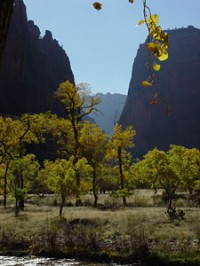 As you stroll along the fine trails that lace the park, study the meandering, intersecting folds and creases of these colossal fixtures and you’ll see evidence of gravity at work, the inexorable strain that’s pulling down sprawling slabs of sandstone, chips off the old block, leaving shallow cups in the broad walls, and deep overhangs and massive mounds stacked in a random jumble up and down the length of the canyon. Everywhere you will see boulders and log debris tossed indiscriminately from great heights by the tremendous force of deadly flash floods that roar through the canyon and have sculpted the columns and towering spires above.
The forces of nature turned the valley’s desert floor into a rich sanctuary fit for human habitation. Anasazi farmers dwelt here; 1,000-year-old pots full of grain were discovered along with other traces of their presence. After the Anasazi moved on to the southeast 800 years ago, the Paiute Indians set up shop, only to be shoved aside by 19th century pioneers of European descent who farmed the productive bottom land and established the communities of Springdale, Rockville and the eventual ghost town of Grafton.
Today it’s tourists and a thriving little economy that caters to the needs of hikers, climbers, naturalists and their students, photographers, campers, lodge-lizards and connoisseurs of fine dining. And the just-plain curious. And star-struck lovers caught in the throes of their passion for beautiful scenery.
As you stroll along the fine trails that lace the park, study the meandering, intersecting folds and creases of these colossal fixtures and you’ll see evidence of gravity at work, the inexorable strain that’s pulling down sprawling slabs of sandstone, chips off the old block, leaving shallow cups in the broad walls, and deep overhangs and massive mounds stacked in a random jumble up and down the length of the canyon. Everywhere you will see boulders and log debris tossed indiscriminately from great heights by the tremendous force of deadly flash floods that roar through the canyon and have sculpted the columns and towering spires above.
The forces of nature turned the valley’s desert floor into a rich sanctuary fit for human habitation. Anasazi farmers dwelt here; 1,000-year-old pots full of grain were discovered along with other traces of their presence. After the Anasazi moved on to the southeast 800 years ago, the Paiute Indians set up shop, only to be shoved aside by 19th century pioneers of European descent who farmed the productive bottom land and established the communities of Springdale, Rockville and the eventual ghost town of Grafton.
Today it’s tourists and a thriving little economy that caters to the needs of hikers, climbers, naturalists and their students, photographers, campers, lodge-lizards and connoisseurs of fine dining. And the just-plain curious. And star-struck lovers caught in the throes of their passion for beautiful scenery.
 My good friend, Cal, loved Zion. She loved it at night under a deep canopy of stars beneath gnarled Freemont cottonwood thick with green leaves, trunks swaying back and forth under the force of tremendous windstorms that race down the canyon with a deafening roar. She loved the drive up the steep switchbacks on Zion-Mount Carmel highway, through those old, narrow dark tunnels and on up to Checkerboard Mesa (6,670’) where the red gives way to shades of pink and cream and the pillows and marshmallows and toadstool mounds of sandstone are etched with exaggerated cross-hatches, the result of the softer stone being scoured by the hard, grinding geologic forces of time.
She loved it all, though she tended to keep her feelings to herself, and wasn’t much of a talker. She left the details of creation to me and contented herself with gazing out the side window at the twisted pine and odd shapes and sizes and those deep cobalt-blue skies that blanket southern Utah. And it’s because of Cal that Zion will always hold an endearing place in my heart. Gentle, undemanding, sweet as pie and forever curious about the natural order, I’ve never known anyone who wasn’t immediately drawn to her loving personality.
But life changed a year-and-a-half ago, swiftly and unexpectedly as these things do. First came the weight loss, then the matting and the bald spots, and the inevitable grim prognosis; it was lodged behind her right eye which she quickly lost. Of course we were initially in denial, and when the time was upon us we packed the SUV and planned one last farewell tour through this most favorite land of hers.
My good friend, Cal, loved Zion. She loved it at night under a deep canopy of stars beneath gnarled Freemont cottonwood thick with green leaves, trunks swaying back and forth under the force of tremendous windstorms that race down the canyon with a deafening roar. She loved the drive up the steep switchbacks on Zion-Mount Carmel highway, through those old, narrow dark tunnels and on up to Checkerboard Mesa (6,670’) where the red gives way to shades of pink and cream and the pillows and marshmallows and toadstool mounds of sandstone are etched with exaggerated cross-hatches, the result of the softer stone being scoured by the hard, grinding geologic forces of time.
She loved it all, though she tended to keep her feelings to herself, and wasn’t much of a talker. She left the details of creation to me and contented herself with gazing out the side window at the twisted pine and odd shapes and sizes and those deep cobalt-blue skies that blanket southern Utah. And it’s because of Cal that Zion will always hold an endearing place in my heart. Gentle, undemanding, sweet as pie and forever curious about the natural order, I’ve never known anyone who wasn’t immediately drawn to her loving personality.
But life changed a year-and-a-half ago, swiftly and unexpectedly as these things do. First came the weight loss, then the matting and the bald spots, and the inevitable grim prognosis; it was lodged behind her right eye which she quickly lost. Of course we were initially in denial, and when the time was upon us we packed the SUV and planned one last farewell tour through this most favorite land of hers.
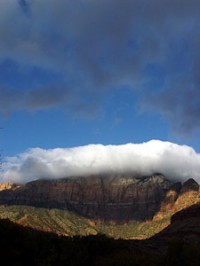 Leaving Dixie, as they refer to this warm corner of Utah, we drove north to spectacular Bryce Canyon with its myriad-upon-myriad of slender pink columns, then east past the deep and exceedingly narrow, sculpted canyons of the Escalante, then east some more along the elegant red walls of the Burr Trail and out onto the wide open landscape of tabletop mesas of pinion and craggy, twisted juniper with their stringy bark that peels off in long strips; through wild, desolate end-of-the-world country, and then north again; driving … driving … driving.
Resignation came just as we crossed over the grand, vaulted fractures of the elongated Waterpocket Fold of Capital Reef National Park; defeat and reluctant acceptance, followed by glimpses of clarity, and a caving-in, that dreadful bottomless pit of impending loss.
As we drove my thoughts of Cal became clear; images and reflections on her all-too-short life paraded across my memory. I saw her sitting on the bed with one leg raised in the air licking herself; or taking in a desert sunset from the roof of the SUV and sliding down the windshield on those furry paws of hers; the purring, the meowing, the way she clattered her teeth in a feline frenzy at the sight of crows and magpies. The manner in which she slept on my chest the night before she died at the hands of that wretched veterinarian on that wretched day.
Leaving Dixie, as they refer to this warm corner of Utah, we drove north to spectacular Bryce Canyon with its myriad-upon-myriad of slender pink columns, then east past the deep and exceedingly narrow, sculpted canyons of the Escalante, then east some more along the elegant red walls of the Burr Trail and out onto the wide open landscape of tabletop mesas of pinion and craggy, twisted juniper with their stringy bark that peels off in long strips; through wild, desolate end-of-the-world country, and then north again; driving … driving … driving.
Resignation came just as we crossed over the grand, vaulted fractures of the elongated Waterpocket Fold of Capital Reef National Park; defeat and reluctant acceptance, followed by glimpses of clarity, and a caving-in, that dreadful bottomless pit of impending loss.
As we drove my thoughts of Cal became clear; images and reflections on her all-too-short life paraded across my memory. I saw her sitting on the bed with one leg raised in the air licking herself; or taking in a desert sunset from the roof of the SUV and sliding down the windshield on those furry paws of hers; the purring, the meowing, the way she clattered her teeth in a feline frenzy at the sight of crows and magpies. The manner in which she slept on my chest the night before she died at the hands of that wretched veterinarian on that wretched day.
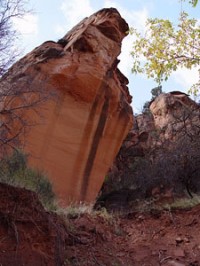 We chose to bury her in the mountains east of Salt Lake City, up high in a remote patch of aspens, among the white bark and shimmering leaves with a view of the valley far below. Digging her grave was no easy feat, but a noisy affair as I toiled with my shovel, clinking and clanking against a stubborn sea of rocks. So I just gave up and sat on the ground and realized that Callie deserved better; much better. She was entitled to rest in a land worthy of her brief, innocent sojourn, someplace special, someplace grand.
So with Callie cooling down on the back seat we drove all night along the dark and lonely Interstate, not speaking, not thinking, immersed in our nothingness, perfectly quiet and staring at the yellow bars flicking by under the glare of our headlights that probed the enveloping darkness. “She’s just a cat,” I muttered as a madman on a motorcycle zipped by. “She’s just a cat,” I thought as I inadvertently slowed to 40 miles an hour at three o’clock in the morning. “She’s just … she’s just. She’s … she’s just a ….”
A powerful blast from a passing semi rocked us from side-to-side, the roar of the diesel engine snapping me out of my doldrums. My hands clutched the vibrating steering wheel as I picked up the pace and inched her back up to 55.
We chose to bury her in the mountains east of Salt Lake City, up high in a remote patch of aspens, among the white bark and shimmering leaves with a view of the valley far below. Digging her grave was no easy feat, but a noisy affair as I toiled with my shovel, clinking and clanking against a stubborn sea of rocks. So I just gave up and sat on the ground and realized that Callie deserved better; much better. She was entitled to rest in a land worthy of her brief, innocent sojourn, someplace special, someplace grand.
So with Callie cooling down on the back seat we drove all night along the dark and lonely Interstate, not speaking, not thinking, immersed in our nothingness, perfectly quiet and staring at the yellow bars flicking by under the glare of our headlights that probed the enveloping darkness. “She’s just a cat,” I muttered as a madman on a motorcycle zipped by. “She’s just a cat,” I thought as I inadvertently slowed to 40 miles an hour at three o’clock in the morning. “She’s just … she’s just. She’s … she’s just a ….”
A powerful blast from a passing semi rocked us from side-to-side, the roar of the diesel engine snapping me out of my doldrums. My hands clutched the vibrating steering wheel as I picked up the pace and inched her back up to 55.
 350 miles later we arrived at the Unhappy Hunting Grounds that offered us a spectacular view into Zion National Park. We chose a mesa south of the Virgin river covered in juniper and pinion and those bushes with the smooth, almost glossy, burgundy-colored bark. After a short hike we found the perfect spot, but instead of rocks I battled clay, on my knees with my shovel, chopping and clawing, soaked in sweat and covered in dirt and wishing this was finally over. Then we wrapped Callie in her favorite Mexican blanket, and sent along a note with personal messages for her eye only, then gently placed her slight body into the earth and poured in a bucketful of tears and covered her for all time.
350 miles later we arrived at the Unhappy Hunting Grounds that offered us a spectacular view into Zion National Park. We chose a mesa south of the Virgin river covered in juniper and pinion and those bushes with the smooth, almost glossy, burgundy-colored bark. After a short hike we found the perfect spot, but instead of rocks I battled clay, on my knees with my shovel, chopping and clawing, soaked in sweat and covered in dirt and wishing this was finally over. Then we wrapped Callie in her favorite Mexican blanket, and sent along a note with personal messages for her eye only, then gently placed her slight body into the earth and poured in a bucketful of tears and covered her for all time.
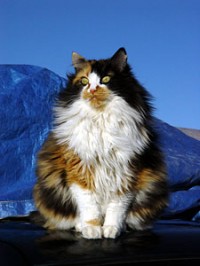 Now I’m not making this up, but a small bunny rabbit hopped out of the brush and watched the somber proceedings, and then a flock of small birds, we’ll call them wrens, swooped in and twittered about in a nearby tree, followed by a half-dozen monarch butterflies floating about our heads and watching over us, and our little calico kitten. I like to believe that.
And so we stood there, arm in arm, gazing at the iridescent glow of Zion, at those stupendous mountains and cliffs and spires, thinking of that unpretentious neurotic bundle of unadulterated love who ate too much and saw us through hard times, and never abandoned us, and caused us no harm. Sure it was a long drive, but we made the right choice bringing Callie home where she belongs.
To the Sanctuary.
To Zion.
Mukuntuweap.
“ From Zion God shines forth, perfect in beauty,” Psalm 50:2
Now I’m not making this up, but a small bunny rabbit hopped out of the brush and watched the somber proceedings, and then a flock of small birds, we’ll call them wrens, swooped in and twittered about in a nearby tree, followed by a half-dozen monarch butterflies floating about our heads and watching over us, and our little calico kitten. I like to believe that.
And so we stood there, arm in arm, gazing at the iridescent glow of Zion, at those stupendous mountains and cliffs and spires, thinking of that unpretentious neurotic bundle of unadulterated love who ate too much and saw us through hard times, and never abandoned us, and caused us no harm. Sure it was a long drive, but we made the right choice bringing Callie home where she belongs.
To the Sanctuary.
To Zion.
Mukuntuweap.
“ From Zion God shines forth, perfect in beauty,” Psalm 50:2View Comments
John Treadwell Dunbar is a freelance writer